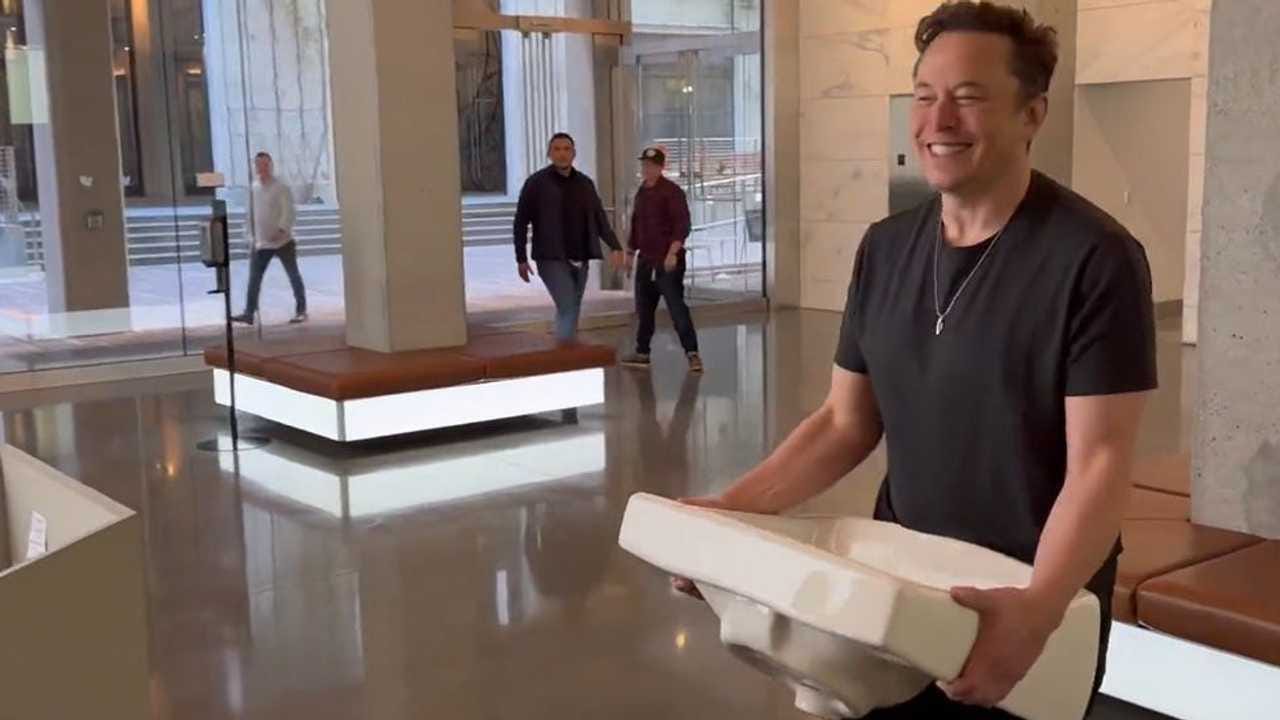📈Just what is Elon up to?
Alex here to talk through the recent developments at Twitter and a bunch of other tech companies, who seem to be feeling the heat from higher interest rates.
Love this post? Send it to a friend and ask them to subscribe! Hate this post? Send it to your worst enemy! They still have an email! And that’s the only way to support us.
After months of will-he or won’t-he, Elon Musk bought Twitter. He arrived at the social media’s home office in his typical understated and reserved fashion by walking in with a literal kitchen sink:
Maybe you, too, would feel it was apt to tote in what looks to be quite a heavy fixture if you just concluded negotiations to borrow $13 billion from a bunch of investment banks and have a Saudi Arabian Prince as one of your equity investors.
After disposing of the said sink (did he hand it to Jason Calacanis once he got his internet lulz?), Elon marched upstairs and promptly fired the CEO and CFO, with a promise of deeper cuts to come. He appears to be following through on that promise today:
Given Twitter’s social and cultural influence and Musk’s own dalliances with what sort of speech he may or may not allow on the platform, these developments were greeted with lots of hand-wringing by many of its verified users (pejoratively known as “Blue Checks” amongst the very online).
He especially got their ire up after floating the idea of charging for their verification status. As usual, it’s hard to discern if the idea is a serious one or if he’s just trolling.
Why does any of this matter for a newsletter that focuses on personal finance and economics? It could very well mark the beginning of a massive shift in what sort of companies dominate the funds you likely hold in your 401(k) or other investment accounts.
Here’s what I mean. Let’s start by putting Musk’s acquisition of Twitter into context.
Twitter came up in the easy money world after 2008 when interest rates were functionally zero. Thousands of companies were showered with cash to bring their product to market on the expectation that one of them would hit it big and become the next world-eating company woven into the fabric of society. Or, at least offer a profitable liquidity event for the founders and VCs (looking at you, Blue Apron).
Famously, that none of these companies actually turned a profit hardly seemed to matter. Once again, HBO’s Silicon Valley nails the upside-down logic:
“It’s not about what you earn; it’s about what you’re worth. And who’s worth the most? Companies that lose money. Pinterest, Snapchat… no revenue. Amazon has lost money every f*ckin’ quarter for 25 f*ckin’ years, and that Bezos motherf*cker is the king.”
As zero interest rates persisted through the 2010s, the incentive structure became clear for entrepreneurs: build a product (it doesn’t have to be a good product, just a marketable one), secure funding to build a big enough business to catch the attention of one of the big guys (Facebook, Apple, Amazon, Netflix, or Google, often abbreviated to FAANG) and cash-out by getting acquired, or cash-out by growing big enough to go public. Repeat.
This cycle is what fed the growth of the FAANG stocks and why, if you looked at one of your investment’s top holdings over the last few years, one or all of them were inevitably in the top 10.
That’s because many funds in your 401(k) are market-cap-weighted, which just means that the biggest company occupies the largest slice of the fund, the second biggest is the second largest holding, etc. Here’s a great visual representation of how the largest companies based on market cap have changed since 1980.
Assuming you’re invested in a market-cap-weighted fund, this means that your investment performance is closely tied to the performance of these big tech names. Your account went up as they got bigger.
That few of them turned a profit hasn’t mattered as much because more money could be borrowed for next to nothing to fund whatever the next idea out of Silicon Valley was and potentially make up the losses with that next winner.
Now that interest rates have risen from zero to around 4%, the game done changed.
Historically, when interest rates go up, banks stop looking for business plans trying to “make the world a better place (eventually… maybe).” Instead of changing the world, banks look for safer strategies like improving the financial performance of an existing company.
To put it back into housing terms, think of it like buying an existing home and remodeling it to rent instead of building a new home from the ground up to then find a buyer.
Which brings us back to Elon.
Think whatever you will of him personally, he’s no dummy. He basically just took out a $13 billion mortgage on top of taking money out of the bank (his Tesla ownership stake) to buy Twitter, a culturally significant tech company with shaky financials and dubious user activity (the bots, man. There are so many bots). In other words, this sure seems like a remodel.
Humans cost money. And, if we assume this is a financial remodel, then the first thing to do is cut headcount. This may sound cruel, but remember, many of these employees are very well-paid engineers whose skillset remains in high demand. They’ll be fine.
Also, it’s got to be a lot easier to cut headcount when this is what passes for a “Day in the Life” of a Twitter employee.
As the top commenter for this video succinctly observed: “The cleaning, maintenance and kitchen staff are the only Twitter employees who actually do any work around there picking up after these spoiled toddlers. They’re the only people I would not fire.”
The next step in a financial remodel is to look for ways to improve the margins on the product, which is where charging for blue verification check mark enters into the equation.
While Twitter is the highest profile tech company going through a financial remodel, it’s hardly alone:
The tech world appears to have gotten the message that higher interest rates are here, and lenders aren’t as interested in world-changing solutions that don’t have a profitable stage just over the horizon.
What’s the Upside?
The Twitter acquisition and financial remodel could signal the end of easy-money, “pre-revenue” tech companies flitting into existence before getting gobbled up, going public under dubious terms, or, most likely flaming out. That’s not inherently a bad thing. Like the Dotcom Bubble twenty years ago, the reckoning forced companies and entrepreneurs to innovate and create the apex companies dominating the marketplace today.
That means that if you diversify your investments with smaller stocks alongside the big stocks, you stand a chance at catching some of these companies and potentially benefiting from their growth.1
For Your Weekend
Read
How Weird Al Yankovic Got His Absurd, Chaotic “Biopic” with Daniel Radcliffe Made by Anna Menta (Decider)
You may think you know the story of Grammy-winning parody musician Weird Al Yankovic. But after you watch his absurdly hilarious biopic, Weird: The Al Yankovic Story, which began streaming free on The Roku Channel today, you’ll realize… you know even less than you did before.
Watch
See How They Run (HBO Max, Prime Video)
Looking for a rainy day mystery to cheer up a gloomy fall day? Turn to See How They Run, the charming Agatha Christie-inspired detective story starring Saoirse Ronan and Sam Rockwell. When a member of a West End play is murdered and staged in the very theater where the production has been ongoing, Inspector Stoppard (Rockwell) and his chipper coworker, Constable Stalker (Ronan) are on the case. The two make for an entertaining duo, and appearances from Adrien Brody, Ruth Wilson and David Oyelowo only sweeten the deal. (Greta Bjornson, Decider)
Chuckle
We strongly suggest using a fund - mutual fund or ETF - instead of trying to do this yourself.










